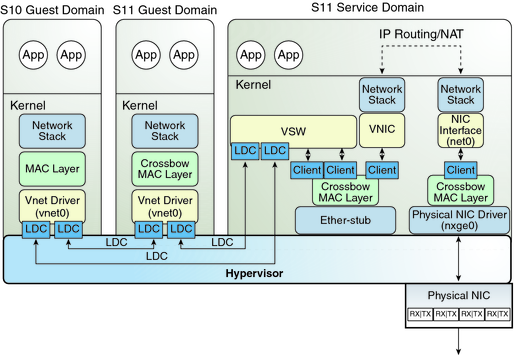| Skip Navigation Links | |
| Exit Print View | |

|
Oracle VM Server for SPARC 3.0 Administration Guide Oracle VM Server for SPARC |
| Skip Navigation Links | |
| Exit Print View | |

|
Oracle VM Server for SPARC 3.0 Administration Guide Oracle VM Server for SPARC |
Part I Oracle VM Server for SPARC 3.0 Software
1. Overview of the Oracle VM Server for SPARC Software
2. Installing and Enabling Software
3. Oracle VM Server for SPARC Security
4. Setting Up Services and the Control Domain
Introduction to a Virtual Network
Oracle Solaris 10 Networking Overview
Oracle Solaris 11 Networking Overview
Virtual Device Identifier and Network Interface Name
How to Find Oracle Solaris OS Network Interface Name
Assigning MAC Addresses Automatically or Manually
Range of MAC Addresses Assigned to Logical Domains
Automatic Assignment Algorithm
Duplicate MAC Address Detection
Using Network Adapters With Logical Domains
How to Determine If a Network Adapter Is GLDv3-Compliant (Oracle Solaris 10)
Configuring a Virtual Switch and the Service Domain for NAT and Routing
Configuring NAT on an Oracle Solaris 10 System
How to Set Up a Virtual Switch to Provide External Connectivity to Domains (Oracle Solaris 10)
Configuring NAT on an Oracle Solaris 11 System
How to Set Up a Virtual Switch to Provide External Connectivity to Domains (Oracle Solaris 11)
Configuring IPMP in a Logical Domains Environment
Configuring Virtual Network Devices Into an IPMP Group in a Domain
Configuring and Using IPMP in the Service Domain
Using Link-Based IPMP in Logical Domains Virtual Networking
How to Configure Physical Link Status Updates
Configuring and Using IPMP in Releases Prior to Logical Domains 1.3
Configuring IPMP in the Guest Domain
Configuring IPMP in the Service Domain
How to Assign VLANs to a Virtual Switch and Virtual Network Device
How to Install a Guest Domain When the Install Server Is in a VLAN
How to Configure a Virtual Switch With an NIU Network Device
Using Link Aggregation With a Virtual Switch
How to Configure Virtual Network and Virtual Switch Devices to Use Jumbo Frames
Compatibility With Older (Jumbo-Unaware) Versions of the vnet and vsw Drivers (Oracle Solaris 10)
Oracle Solaris 11 Networking-Specific Feature Differences
11. Managing Domain Configurations
12. Performing Other Administration Tasks
Part II Optional Oracle VM Server for SPARC Software
13. Oracle VM Server for SPARC Physical-to-Virtual Conversion Tool
14. Oracle VM Server for SPARC Configuration Assistant (Oracle Solaris 10)
16. Using the Oracle VM Server for SPARC Management Information Base Software
17. Logical Domains Manager Discovery
18. Using the XML Interface With the Logical Domains Manager
In the Oracle Solaris 10 OS, the virtual switch (vsw) is a layer-2 switch, which also can be used as a network device in the service domain. The virtual switch can be configured to act only as a switch between the virtual network (vnet) devices in the various logical domains but with no connectivity to a network outside the box through a physical device. In this mode, creating the vsw as a network device and enabling IP routing in the service domain enables virtual networks to communicate outside the box using the service domain as a router. This mode of operation is very essential to provide external connectivity to the domains when the physical network adapter is not GLDv3-compliant.
The advantages of this configuration are:
The virtual switch does not need to use a physical device directly and can provide external connectivity even when the underlying device is not GLDv3-compliant.
The configuration can take advantage of the IP routing and filtering capabilities of the Oracle Solaris OS.
The following diagram shows how a virtual switch can be used to configure Network Address Translation (NAT) in a service domain to provide external connectivity for guest domains.
Figure 8-5 Virtual Network Routing

If assigning an address, ensure that the virtual switch has a unique MAC address.
primary# ldm add-vsw [mac-addr=xx:xx:xx:xx:xx:xx] primary-vsw0 primary
See How to Configure the Virtual Switch as the Primary Interface for more information about creating the virtual switch.
See How to Configure the Virtual Switch as the Primary Interface for more information about configuring the virtual switch device for DHCP.
For more information about IP routing, see Packet Forwarding and Routing on IPv4 Networks in System Administration Guide: IP Services.
The Oracle Solaris 11 network virtualization features include etherstub, which is a pseudo network device. This device provides functionality similar to physical network devices but only for private communications with its clients. This pseudo device can be used as a network back-end device for a virtual switch that provides the private communications between virtual networks. By using the etherstub device as a back-end device, guest domains can also communicate with VNICs on the same etherstub device. Using the etherstub device in this way enables guest domains to communicate with zones in the service domain. Use the dladm create-etherstub command to create an etherstub device.
The following diagram shows how virtual switches, etherstub devices, and VNICs can be used to set up Network Address Translation (NAT) in a service domain.
Figure 8-6 Virtual Network Routing

primary# dladm create-etherstub stub0
primary# ldm add-vsw net-dev=stub0 primary-stub-vsw0 primary
primary# dladm create-vnic -l stub0 vnic0
primary# ipadm create-ip vnic0 primary# ipadm create-addr -T static -a 192.168.100.1/24 vnic0/v4static
See Setting IP Interface Properties in Connecting Systems Using Fixed Network Configuration in Oracle Solaris 11.1 and Packet Forwarding and Routing on IPv4 Networks in System Administration Guide: IP Services.